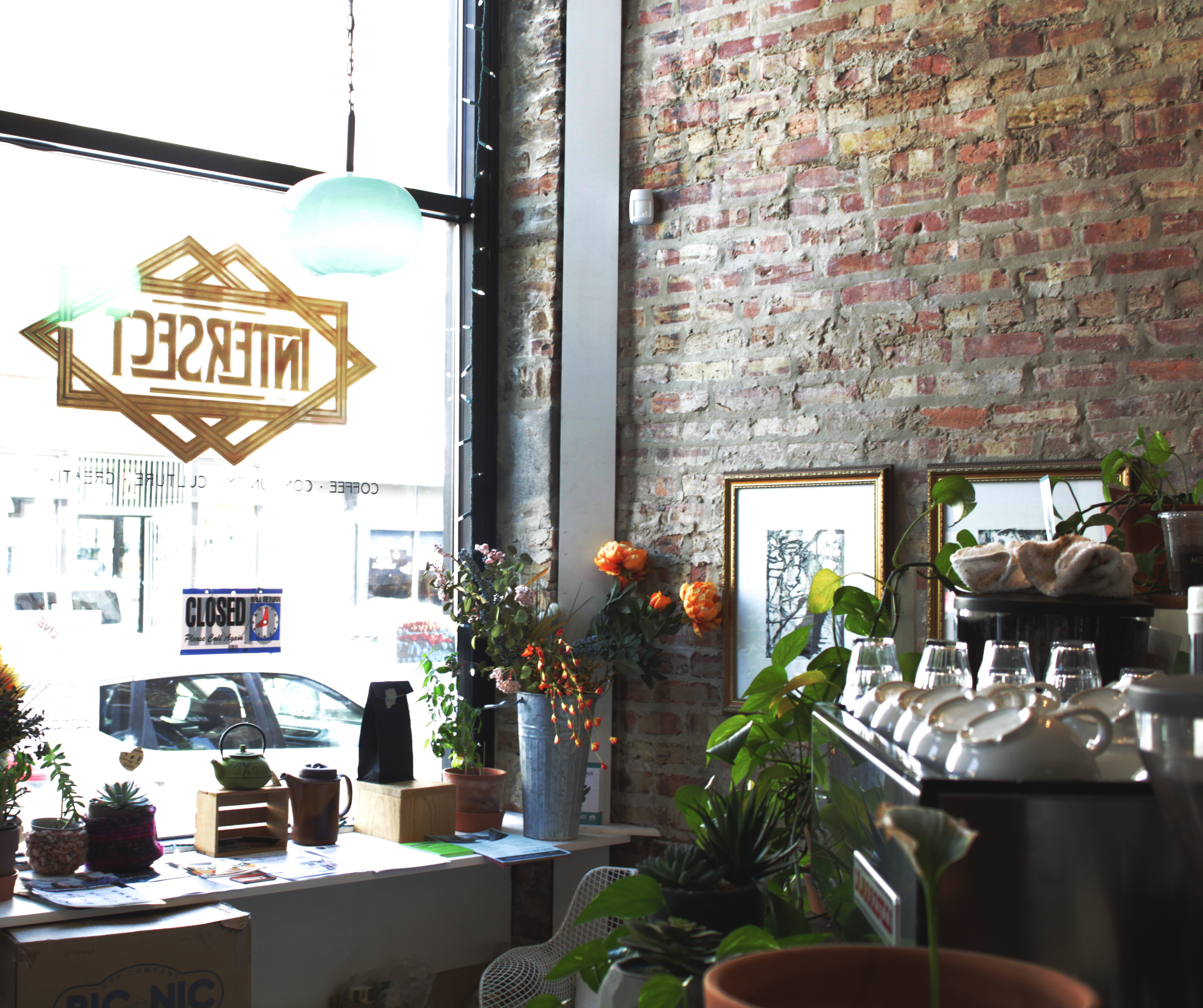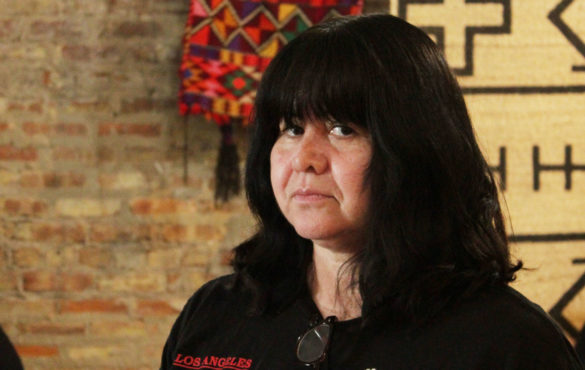Teresita Carson Valdéz works in fiber, film, photography, printmedia and installation. She received her BFA from SAIC. Recent exhibition sites include Sullivan Galleries, Adds Donna and Mana Contemporary. Her awards include winning first prize for her screenplays Poly Esther, Chucky’s Feast, 1st and 10, Shlomo’s Night Out, and Ratacholo. Her short films have been shown at festivals around the world and at the Museum of Contemporary Art of San Diego.
Alex Janakiraman: In your artist statement, you talk about collective history and personal history – how do you think about time?
Teresita Carson Valdéz: I read recently about the difference between Kronos and Kairos to the Greeks. Kronos is Western, linear time. Kairos are those time-related occurrences that we can’t explain, like déjà vu. Non-westerners – Indians, Aztecs, Mayans – all divide time in different ways. My practice is based a lot in cultural production through migration – not just of people, but objects. I can do a performance with film, paint on film, photograph it, then start to print on textiles or paper and use those images in collage. Time is collage: if you really try to remember your life, you don’t know what you’re remembering, you’re remembering the last memory that you had.
AJ: Within this framework, could you tell me about your childhood and how you’ve gotten to where you are now?
TCV: I grew up in Mexicali, Baja California, and immigrated to San Diego when I was a teenager. I took classes at many schools, but eventually started to take my photography practice seriously. When I moved to Chicago 3 years ago, for the first time I felt like an immigrant, because of the segregation of the city. You either have to be this or that — what the white western world tells you is Mexican or what other Mexicans tell you is Mexican — but what we know as Mexican culture was really manufactured by the government after the revolution. I had to do a lot of thinking and dwelling in nostalgia, trying to make sense of where I was. But disidentification happens. Pilsen used to be Polish Czech, and then Mexican communities colonized it, which is visible especially looking at that church that has scaffolding around the towers [St. Adalbert’s, now closed]. This architecture and the negative space remind me of the Mayan arches, and the Spanish-built cathedrals on top. We need to look at culture and life from the side and backwards and in every direction, but that’s not what Western thought teaches us. We’re basically sitting in ruins all the time; we need to think about constant construction and deconstruction. That manifests in the self as well. If you had a traumatic experience and you buried it, to get to it you have to dig. I took this turn in the past three years of working through that, going back to the idea, in terms of time, of being in exile. If your first language was not English but you’re forced to work in English, it’s always filling this displacement, like Kafka and the idea of minor literature. Before I moved to Chicago, my practice was very much a performative, image and text based interplay. Now I’m really into queer formalism. Although I don’t identify as queer necessarily, I think if you’re not a cis white male, then you’re something else. That’s the whole point. Normativity is the thing that’s not normal.
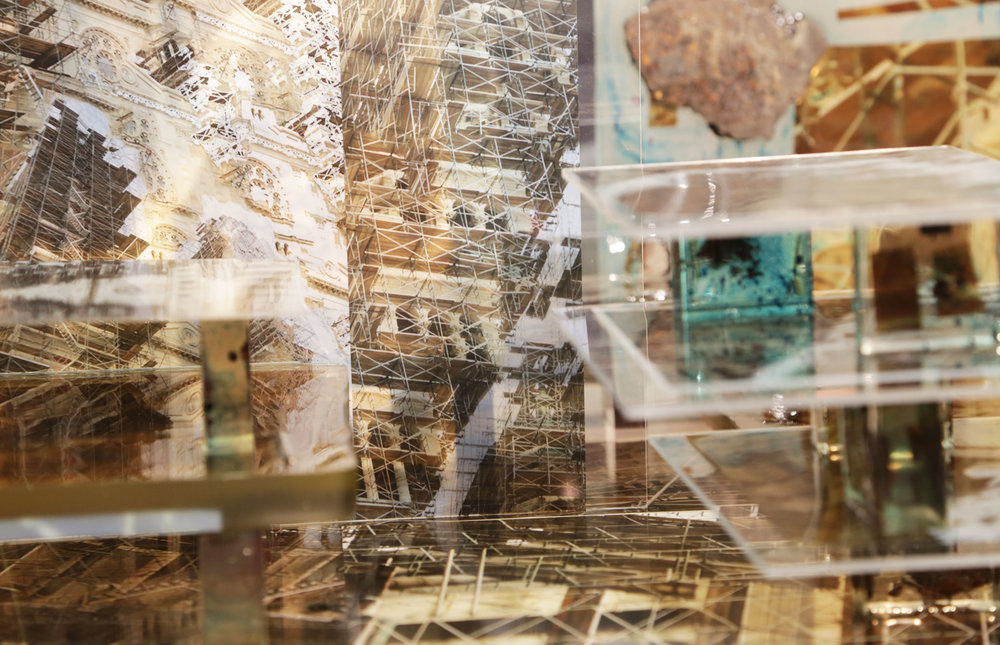
Salvage: After T’ho. Multidisciplinary installation made from thinking about the negative space in architecture, specifically the scaffolding around St. Adalbert’s.
AJ: Could you talk more about your process and why film photography works for you?
TCV: I love the magic of seeing the image appear, and also the fear that you did something wrong and nothing is going to be there. If I know how it’s going to turn out I’m not interested. I’m very experimental with medium, always. When I’m weaving I’m not interested in repeating the same structure; I set it up and see what surprises come. Even etching or screenprinting is not about editioning, it’s about the high of the surprise. To me there’s process, and what’s made is just the evidence of that. If I can’t push it further, I move on to something else. One of my professors always said: you don’t adapt the idea to the form, the form adapts to the idea.

A recent weaving by Teri.
AJ: What reactions do you want from your work? Do you think people need to understand the context and histories that you’re referencing?
TCV: Sometimes I struggle with that, because people are attracted to my work on an aesthetic level. My last installation was about a very horrible ugly thing: feminicide in Mexico. Femicide and feminicide are not the same thing. Femicide is killing a woman because she’s a woman. Feminicide is the killing of women in a system that creates the perfect conditions for it to happen. I printed silk and at first glance it’s very beautiful, it’s pink, bright, and moving… but when you get closer, you hear women talking about their daughters and the sounds of protest in Mexico.
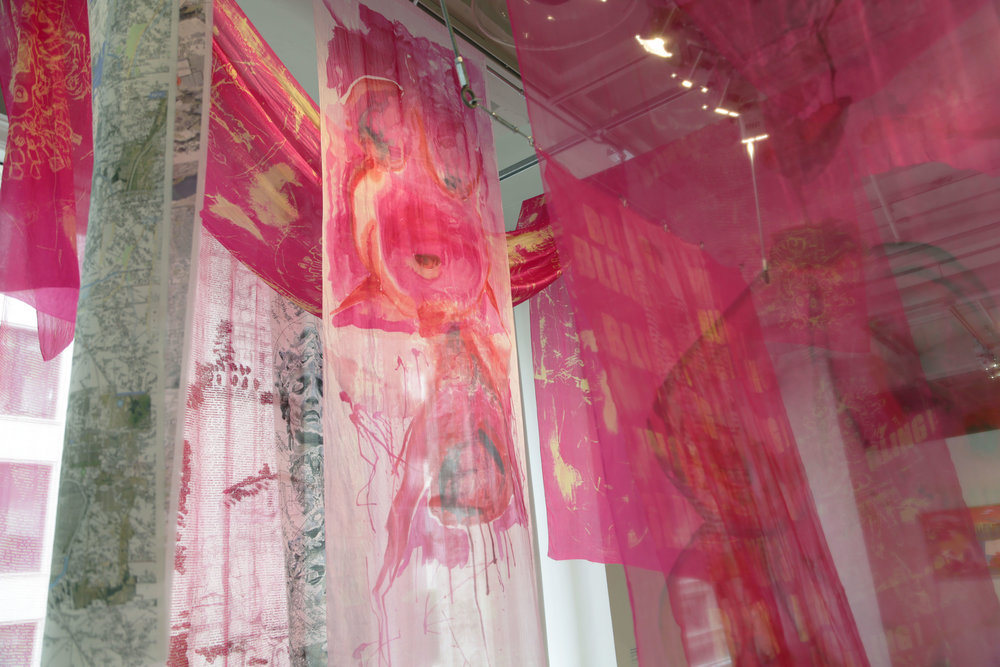
Monument for the Disposable, Or, Declaration of Value.
But it’s not about who I am as an artist or what I am trying to say. That installation is for women and if you want to get more specific, for Mexican women, or women from countries where violence against women is state-sponsored. I don’t think you have to know a lot to understand when you hear the pain in a mother’s voice.
AJ: What was your process of making that installation?
TCV: That was such a process! I was living in Logan Square at the time, and feeling segregation, I started looking for signifiers of culture. When you go to Mexican businesses you always see the Guadalupe Virgin. I started excavating the histories behind her. The Catholic priests colonizing Mexico had to come up with a narrative to unify Mexico. The indigenous people were pretending to come around to Catholicism but would still worship the Aztec goddess, so priests made this brown virgin that was Mary but also incorporated symbolism from the indigenous goddesses. They created a myth that she appeared to the city and said to build a church here. You go back and start looking at the female deities of the Aztecs and they were very feared. Monster is what men, if you start misbehaving, call you. It’s that idea of the “monster” – which the patriarchy has tried to squash – which is powerful. To me it was about creating sort of like my own deity, who women that are suffering at the hands of the patriarchy can look up to – bring her back. I did a drawing and many iterations of Coatlicue, the famous sculpture at the Museo Nacional de Antropología, and started to distill that image. How did we get from all powerful deities to women being powerless and disposable in Mexico? Different cultures have similar stories, and to me it’s important to move through these mythologies so we can enter consciousness in a different way. We can talk about feminism in many ways, but storytelling always make people think.
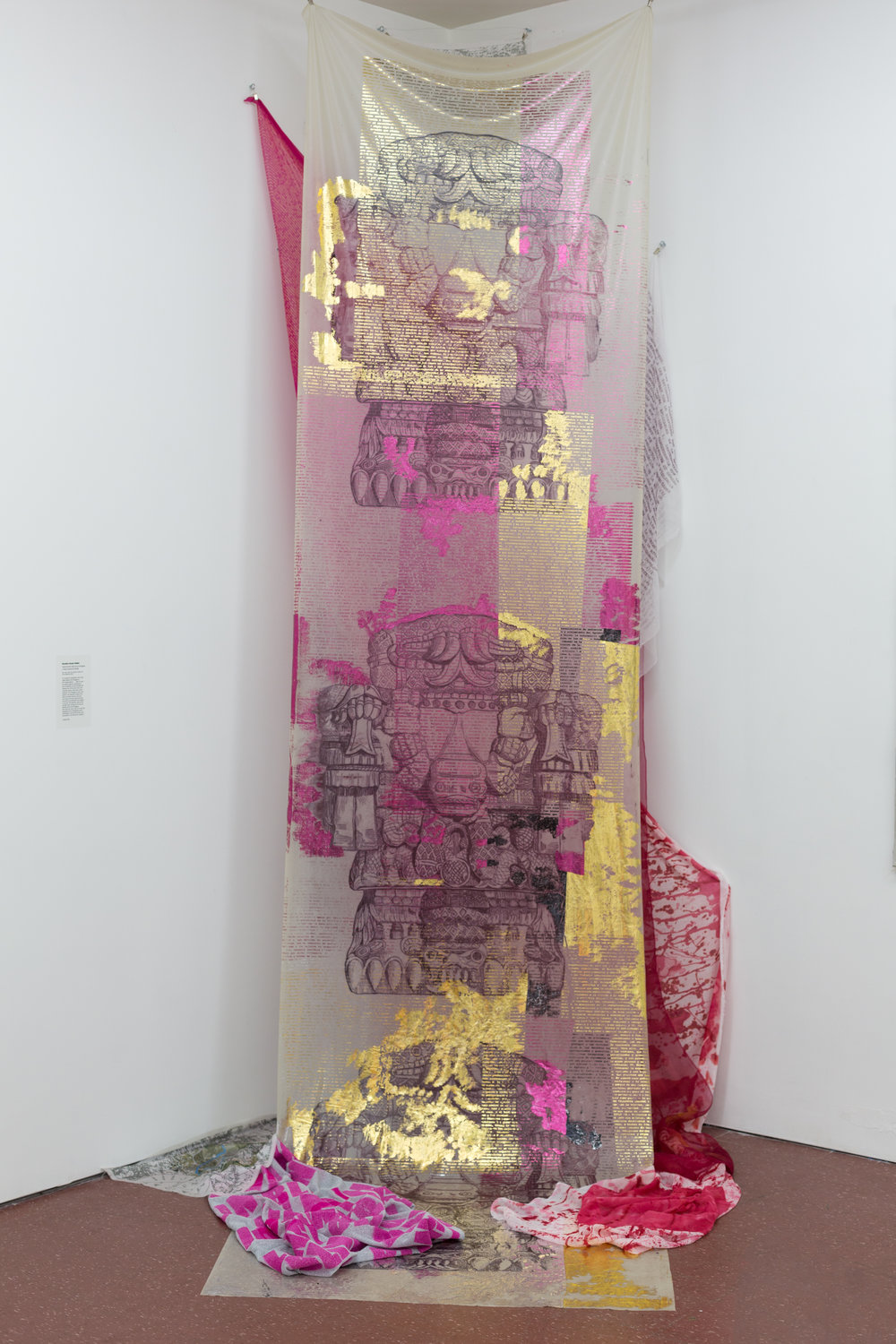
Todos Somos Hijos de la Chingada y Todos Queremos Bling!
I’m also trying to interplay the migration of violence. I had a panel with a map of a product from a maquiladora to a suburb in Illinois, a migration parallel to feminicide. It’s caused by NAFTA and the migration of people who have to work in factories because of the dissemination of agriculture from the center of Mexico. Are we not complicit if we’re buying products made in Mexico or working for companies that use Mexican labor? Young women are trying to get to work and that’s when they disappear. It could be a serial killer, a cop, anybody, and they’re protected by the state sponsored creation of this system. You think that things have gotten better, but for who? Which women? When Trump became president, people of color were like well it’s expected and we have to keep doing what we’ve always been doing, because nothing has changed. But white liberals were losing their shit, because, finally, their way of life was being threatened. And all this is really inherent in the voices of the women; it’s all in Spanish but pain has language. You can try to create a container with the way that you arrange an exhibit or an installation but really sound is what calls to you. I think that when you distill it to installation, art can really reach beyond the trained artist to any audience.
AJ: What are you working on currently?
TCV: Everything is based on what I’m experiencing in the moment. There comes a certain point where the sense of urgency is too much to bear. So, do you just retreat and check out of life? Or do you use your knowledge and your resources to do something? You just make a gesture with what you have and what I have is a lot of skills and a lot of knowledge. But I can’t keep it to myself. I think that’s the most important part. I have this coffee shop, Intersect, in Pilsen, and in the back I have a space I try to activate with gestures that extend to the community. Sometimes it’s just me at the table making. I look at that table as a site that needs to be activated by people’s interest – asking what I’m doing, wanting to sit down, make together, and talk.

Front cafe space at intersect.

Inside the back room at Intersect, with two large tables for working or creative workshops and collected art all over the walls.
Every conversation is different. Photography, film, and installation can be a little too much. Some people check out of contemporary art because they don’t understand it or want to understand it, or they feel intimidated. Craft is the perfect entryway to art aesthetics and conversations. We all start at the same point and know that sensorial experience from the warmth of the womb directly into the warmth of a blanket. I’ve had a four year old weave on a cardboard loom. She did it because kids like to do stuff, but then when she started to see that cloth, she realized oh, I’m making a blanket for my unicorn. That’s how we all begin. It doesn’t matter what her ethnicity is or what color she is or what she comes from. Once the cloth starts to build, the amazement and discovery in people is . . . you just have to be there to feel it.

The space is filled with small fiber pieces made by Teri.
AJ: Do you feel like you’ve built a community around Intersect and in general in Chicago?
TCV: It still hasn’t become what I thought it would, but I see it like I see my practice: it’s just about having it, being there and being surprised. We’ve had performance artists, open mics, experimental sound night. You do what you want to do; tell us how we can help you and we’ll make it happen. I’m empowering myself by empowering people because that’s the way I’m coping with what’s going on. I just want young people to get out of that funk of anxiety, get out of bed and not be afraid. Teen girls come in and they don’t even want to talk to you. Then we start the workshop and they’re writing poetry. And at the end of the day they’re standing in line to get up on stage and read. To see that happen in six hours is amazing.

Stage space in the back room at Intersect, with fiber work by Teri visible in the left, covering her office window.
I guess right now I’m using people as material, but that’s just the way I’m coping with what’s going on in this country and getting worse and worse. I think it’s important for anyone who reads this to know that I have the space and it’s available. It’s ready to be activated in any way you want to. I aspire to put art in a public place where people can have access to it. Access is important. I want to give opportunities to people, do whatever I can do with whatever I have. That’s the goal.
Keep up with Teri on Instagram @dizzydentfilms, check out her website, and be sure to head to Intersect at 1727 W 18th Street!
